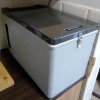Well done Nealh, good idea to get up to date coverage all in one place.
Static charging and my self sufficient bike have both similarities and substantial differences too.
Static system, efficiency is nice to have, but not the end of the world if not too high because component costs are much lower than 10 years ago. You might use what you already have as a starting point, and go in stages, learning along the way.
Mobile system, light weight and high efficiency are essential. So here, it has to be best panels that can be afforded, best charge controller, and straight to the battery. There is little sense in going via a buffer battery, inverter and charger. Too much weight, too much lost in conversion.
Apart from wiring, connectors, fuses and measuring equipment, there are only five components involved.
1. Panels
Solar PV panels, also often called modules. For static systems, glass surfaced, heavy and fairly cheap. For mobile systems, lightweight, plastic surfaced, and if any good, quite expensive.
Small glass panels get increasingly expensive per W as size gets smaller. Anything less than 50W not worth bothering with. 100W not much more expensive, and cheapest option is secondhand 250W panels from solar farm upgrades. Try Bimble Solar and I have used triplesolar on eBay.
For mobile use, Sunpower cells, ideally in Sunpower modules. I bought a batch from Bimble, and they were really helpful.
2. Charge controller.
DIFFERENT depending on your requirements.
Direct charging of bike battery usually requires STEP UP or boost controller, a relatively uncommon thing. Elejoy MU400SP for cheap, adjustable voltage, built-in display, robust, or Genasun for state of the art, not adjustable voltage, no display, very expensive.
Charging intermediate battery of 12 or 24 V lead acid or LiFePO4 usually needs STEP DOWN charge controller, which is the normal kind. Good makes are Victron, and Steca. Victron is almost a 'Hoover' like name in off grid circles. Be careful to choose right model according to maximum panel voltage, max current, and check LiFePO4 support if relevant.
3. Battery
If a buffer battery, and lead acid, needs to be pretty big. Ideally double or more the nominal capacity of your bike battery so that it is not run too low in use, which can drastically shorten life.
Otherwise it is your spare? bike battery, ready to swap out. Worth seeing if a spare bike battery, directly charged is the cheapest option if starting with a blank page.
4. Inverter
I have used Sterling Power mostly, and for my Shimano chargers have had no problems with their quasi sine wave models.
I run a 1.8A charger off a 150W inverter, and the 4.6A charger off 1000W inverter, as I don't have anything in between.
5. Battery charger.
Which you already have.










